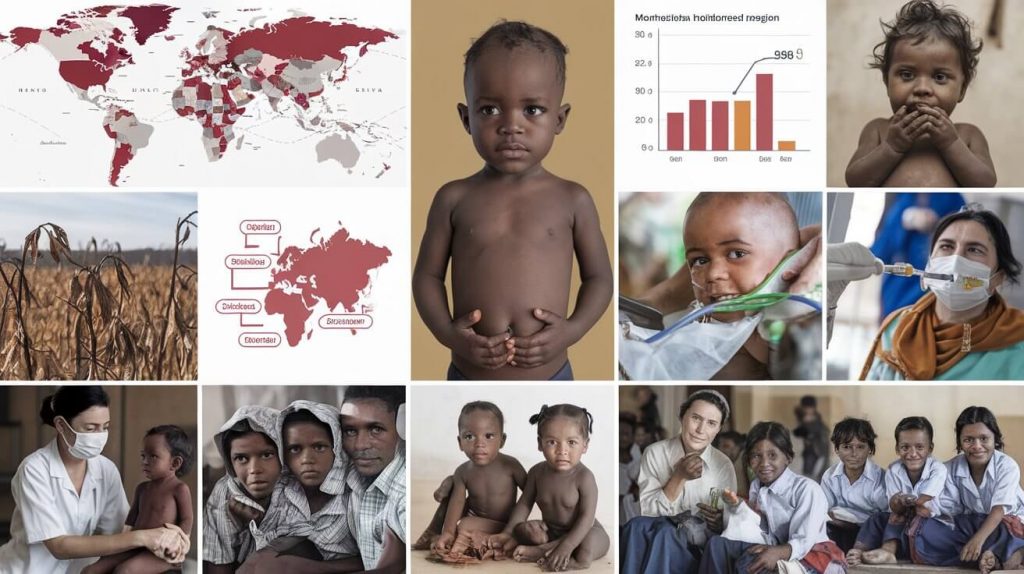
A Look at Undernutrition and Overnutrition
Malnutrition is a significant global health challenge, affecting millions of individuals across diverse socio-economic backgrounds. It manifests in two contrasting yet equally concerning forms: undernutrition and overnutrition. Understanding malnutrition is crucial for tackling its underlying causes and addressing its far-reaching consequences. By comprehending how malnutrition impacts individuals and communities, we can work towards effective solutions that promote healthier lives.
Undernutrition: The Silent Threat
Undernutrition occurs when the body does not receive adequate nutrients essential for growth, repair, and overall functioning. This form of malnutrition is more prevalent in impoverished regions but can affect individuals across all demographics.
- Causes: Undernutrition often stems from poverty, food insecurity, and limited access to healthcare. Natural disasters, armed conflicts, and economic instability further exacerbate the issue by disrupting food supply chains and reducing the availability of nutritious food.
- Effects: Chronic undernutrition leads to stunted growth, weakened immune systems, and increased vulnerability to infections and diseases. In children, it can result in developmental delays that affect learning and productivity later in life.
- Global Impact: Undernutrition is most pronounced in regions like Sub-Saharan Africa and South Asia, where poverty and inadequate public health systems are significant barriers to combating this crisis.
Despite advances in global health, the persistence of undernutrition highlights the need for systemic change to ensure vulnerable populations have access to adequate nutrition.
Overnutrition: A Growing Concern
While undernutrition reflects a scarcity of nutrients, overnutrition is characterized by an overabundance of calories with insufficient nutritional quality. Overnutrition is increasingly common in developed nations but is also rising alarmingly in urban areas of developing countries.
- Causes: Overnutrition is fueled by sedentary lifestyles, overeating, and a heavy reliance on processed and fast foods. The globalization of unhealthy dietary habits has contributed to this issue, with sugary drinks, snacks, and high-fat meals becoming staples in many diets.
- Effects: The consequences of overnutrition include obesity, type 2 diabetes, cardiovascular diseases, and certain cancers. These conditions not only reduce life expectancy but also place an enormous burden on healthcare systems worldwide.
- Epidemic Status: In developed nations like the United States and parts of Europe, overnutrition has reached epidemic proportions. Simultaneously, urbanization and changing lifestyles have driven its prevalence in rapidly developing economies like India and Brazil.

Understanding malnutrition means recognizing that overnutrition is not just about consuming too many calories—it’s about the imbalance between energy intake and nutritional needs.
Bridging the Gap: Sustainable Solutions
Bridging the Gap: Sustainable Solutions

Addressing malnutrition in all its forms requires a multifaceted approach that combines education, policy reform, and personal responsibility.
- Community Education: Public awareness campaigns can help individuals make informed dietary choices. Teaching the importance of balanced meals, portion control, and the benefits of whole foods can foster healthier eating habits.
- Policy Changes: Governments play a critical role in combating malnutrition by implementing policies that promote food security and access to nutritious foods. Subsidizing healthy options, regulating food advertising, and improving school meal programmes are effective strategies.
- Personal Responsibility: On an individual level, incorporating diverse, nutrient-rich foods into daily meals is essential. Simple changes, such as replacing processed snacks with fruits or adding more vegetables to meals, can make a significant difference.
Nutrition Beyond Calories
To fully grasp the understanding of malnutrition, it’s essential to look beyond calorie counts and focus on the quality of nutrients consumed. Both macronutrients (proteins, carbohydrates, and fats) and micronutrients (vitamins and minerals) play pivotal roles in overall health.
- Micronutrient Deficiencies: Even individuals with adequate calorie intake can suffer from malnutrition due to deficiencies in key micronutrients. Common deficiencies include iron, iodine, and vitamin A, which can lead to anaemia, goitre, and impaired vision, respectively. Addressing these deficiencies is crucial for reducing global health disparities.
- Holistic Nutrition: Achieving a balance of macronutrients and micronutrients is the foundation of good health. A diet rich in whole grains, lean proteins, healthy fats, and a variety of fruits and vegetables ensures optimal nutrient intake.
Action for Change
Malnutrition in all its forms—whether undernutrition or overnutrition—demands urgent and comprehensive solutions. By focusing on understanding malnutrition, we can address the underlying issues and implement sustainable strategies for change. Governments, healthcare providers, and individuals must work collaboratively to tackle this dual burden and create a healthier, more equitable world.
Education is the first step. Raising awareness about the importance of balanced diets and the dangers of poor nutrition can empower communities to make informed choices. Policy interventions, such as improving access to nutritious foods and creating healthier food environments, are critical for large-scale impact.
At the individual level, small, consistent changes to dietary habits can have profound effects. Embracing a diverse and nutrient-rich diet, staying active, and limiting processed foods are simple yet effective ways to combat malnutrition.
Ultimately, understanding malnutrition means acknowledging that it is not merely a personal issue but a global challenge that requires collective action. By addressing both undernutrition and overnutrition, we can ensure healthier, more prosperous lives for generations to come.



